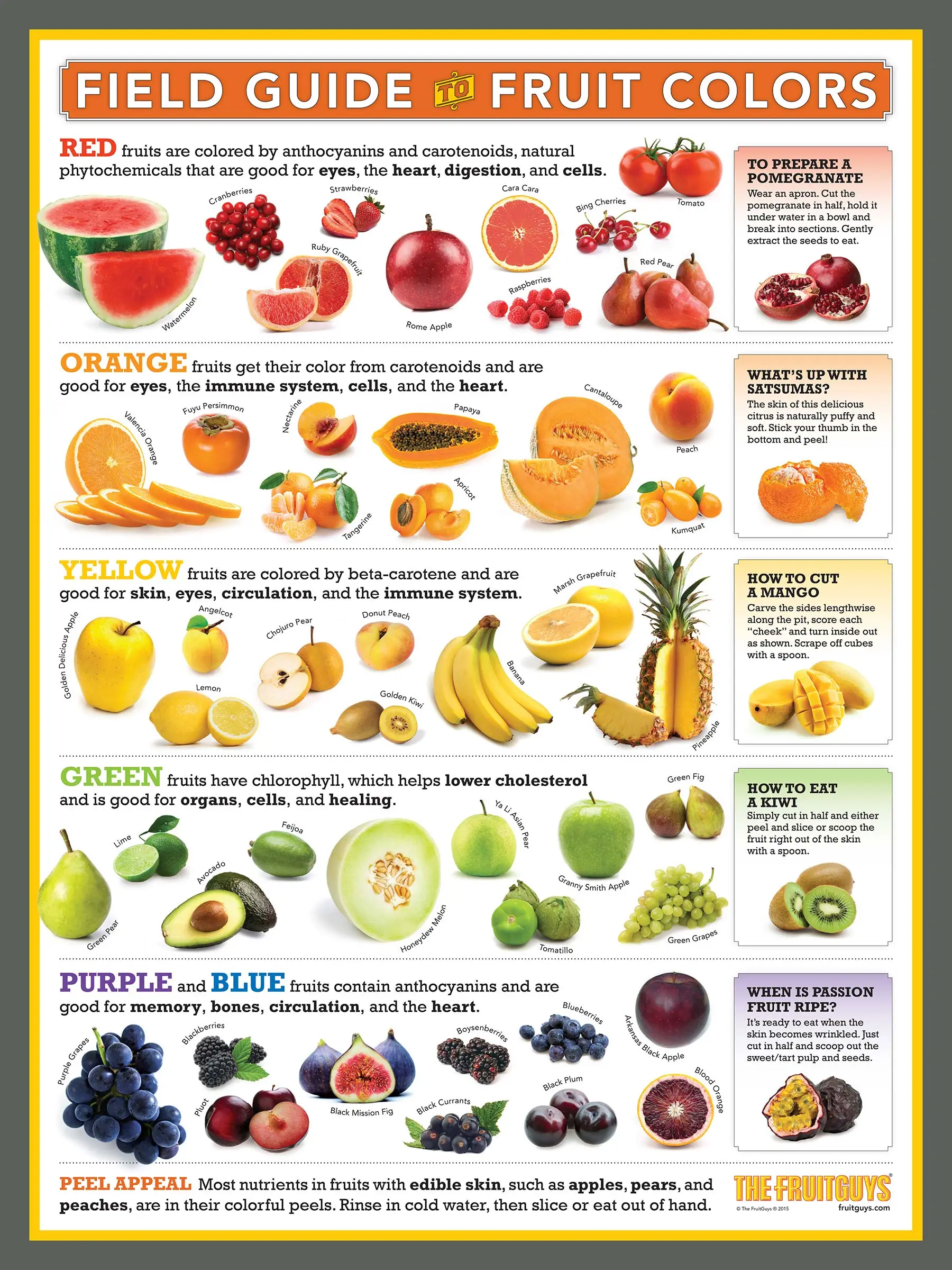Fruits come in a stunning array of colors, and they each have unique health benefits thanks to their natural phytochemicals. Whether you’re aiming to improve your heart, skin, or memory, there’s a fruit color family that can help.
In this fruit color guide, we’ll explore how different fruits and their colors can contribute to your wellbeing.

Red Fruits: Boosting Heart Health and Digestion
Red fruits like strawberries, cherries, and pomegranates owe their vibrant color to anthocyanins and carotenoids. These natural phytochemicals are fantastic for your heart, eyes, and digestive system. Red fruits are known for their ability to boost cell function, reduce inflammation, and improve circulation.
Fruitful Tip: Pomegranates may seem tough to prepare, but by cutting the fruit into sections and tapping the back, you can easily release the seeds. This trick ensures you get the maximum benefit from this powerful red fruit.
How to Prepare a Pomegranate
Wear an apron. Cut the pomegranate in half, hold it underwater in a bowl, and break it into sections. Gently extract the seeds to eat.
Orange Fruits: Enhancing Immunity and Vision
Orange fruits, such as oranges, peaches, and mangoes are rich in carotenoids, which are known for supporting eye health, strengthening the immune system, and improving heart health. Carotenoids are also antioxidants that help protect cells from damage.
Fruitful Tip: Mangoes can be tricky to cut, but a simple “peel and slice” method works wonders. First, cut the fruit into sections and remove the seed to enjoy its juicy goodness.
What’s Up With Satsumas?
The skin of this delicious citrus is naturally puffy and soft. Stick your thumb in the bottom and peel!
Yellow Fruits: Encouraging Healthy Skin and Circulation
Yellow fruits like bananas, pineapples, and lemons get their color from beta-carotene, which is not only great for your skin but also supports healthy eyes and circulation. Beta-carotene helps us produce Vitamin A, which is essential for maintaining healthy skin and vision.
Fruitful Tip: Satsumas are a breeze to peel. Just tear them apart to reveal their juicy segments, making them a perfect snack or addition to a fruit salad.
How to Cut a Mango
Carve the sides lengthwise along the pit, score each “cheek,” and turn inside out. Scrape off cubes with a spoon.
Green Fruits: Lowering Cholesterol and Supporting Healing
Green fruits such as kiwis, avocados, and green apples contain chlorophyll, a powerful nutrient that helps lower cholesterol levels and supports overall healing. Green fruits are also fantastic for organ health, aiding in detoxification and cell repair.
Fruitful Tip: Kiwis are delicious but can be a bit tricky to eat. Try slicing them in half and scooping out the flesh with a spoon for a hassle-free experience.
How to Eat a Kiwi
Simply cut it in half and either peel and slice it or scoop the fruit right out of the rind with a spoon.
Purple and Blue Fruits: Improving Memory and Bone Strength
Purple and blue fruits, like blueberries, grapes and figs, are rich in anthocyanins, which help improve memory, strengthen bones, and support heart health. These fruits also promote healthy circulation and are packed with antioxidants to fight aging and disease.
Fruitful Tip: Grapes and figs are easy to snack on as-is, but try adding them to salads or smoothies for an extra health boost.
When is Passion Fruit Ripe?
It’s ready to eat when the skin becomes wrinkled. Just cut it in half and scoop out the sweet/tart pulp and seeds.
Peel Appeal: The Nutritional Power of Fruit Skins
Don’t forget the peels! Many fruits, like apples, pears, and peaches, have colorful peels that contain the highest concentration of nutrients. Rinsing the fruit in cold running water and eating it with the skin on ensures you get all the benefits and nothing goes to waste.
Let’s Recap: Fruit Color Benefits at a Glance
- Red Fruits: Great for heart health, digestion, and eye health
- Orange Fruits: Support your eyes, immune system, and heart
- Yellow Fruits: Boost skin health, circulation, and vision
- Green Fruits: Lower cholesterol and support healing
- Purple and Blue Fruits: Improve memory, circulation, and bone health
- Peel Alert: Don’t toss that skin—fruit peels pack a punch of nutrients, so leave them on for extra health perks
How to Incorporate More Color Into Your Diet
You might have heard that it’s healthy to “eat the rainbow,” and it’s true! The so-called rainbow diet is all about eating a variety of colorful fruits and vegetables, each offering its own unique set of health benefits.
The natural pigments that give fruits their vibrant hues—such as anthocyanins, carotenoids, and chlorophyll—are packed with powerful nutrients like antioxidants, vitamins, and minerals. Eating a wide range of colors ensures you get the full spectrum of nutrients your body needs for optimal health.
Here are a few rainbow diet tips to help you get started:
- Breakfast: Throw berries, bananas, and even citrus into your smoothie, or top your yogurt with kiwi, pineapple, and a few slices of apple. You can make frozen fruit packs ahead of time to speed up the smoothie-making process.
- Lunch: Add orange bell peppers, cherry tomatoes, cucumbers, red onions, and purple cabbage to your veggie-based salad. For a fruit salad, create a “rainbow bowl” with a mix of fruits in every color—berries, citrus, kiwi, and grapes.
- Snacks: Keep a variety of whole fresh fruits like apples, grapes, and mangoes on hand for easy snacking throughout the day. Choose fruits from different color groups for a mix of vitamins and antioxidants.
- Dinner: Add colorful vegetables like red bell peppers, carrots, sweet potatoes, and dark leafy greens to your go-to recipes. You can stir-fry, roast, or steam them to make your meals more vibrant and nutrient-dense.
Bonus Tip: When in doubt, simply add one more color to your plate. Try mixing berries into your oatmeal or adding a handful of colorful vegetables to your pasta.
Make Eating the Rainbow Easy with The FruitGuys
Eating the rainbow doesn’t need to be complicated. Just aim to include at least two or three different colors on your plate at each meal, and snack on fresh fruits and veggies when you’re feeling peckish.
If you’re not sure where to start, regular deliveries of fresh produce from The FruitGuys can help. We’ll deliver right to your office or home so that your pantry and fridge stay stocked! Browse our healthy produce and snack boxes to kickstart your journey toward a healthier you.


